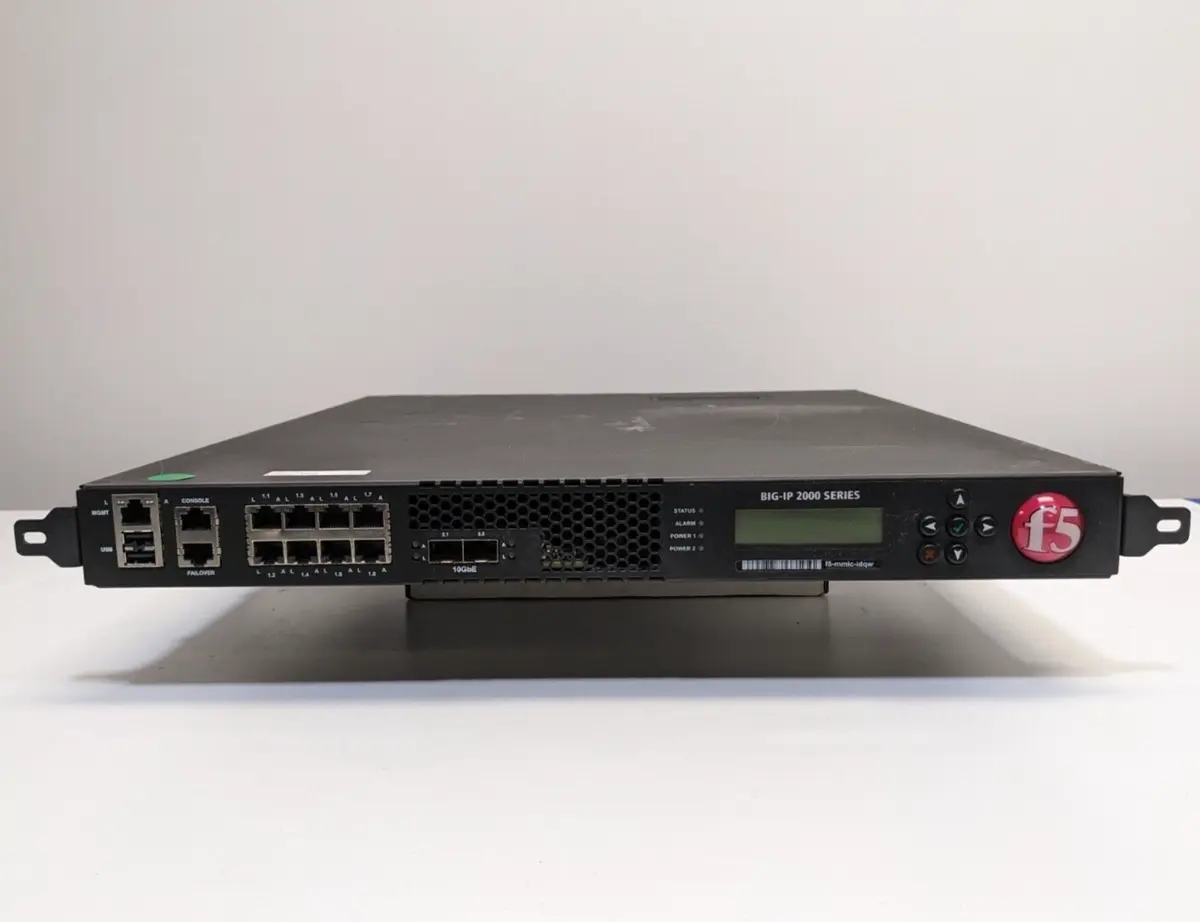What is Big IP?
Big IP is a powerful and versatile application delivery controller (ADC) offered by F5 Networks. It acts as a traffic management device that ensures the efficient and secure distribution of network traffic across multiple servers, providing enhanced reliability, scalability, and performance for organizations. By intelligently distributing incoming requests, Big IP helps optimize server resources, minimize response time, and improve user experience.
At its core, Big IP acts as a load balancer, evenly distributing traffic across servers to prevent any single server from becoming overwhelmed. It achieves this through a variety of load balancing algorithms, including round-robin, least connections, and IP hash, allowing organizations to choose the most suitable algorithm for their specific needs.
Additionally, Big IP offers advanced traffic management features such as SSL offloading, content caching, and application layer security. SSL offloading, for instance, allows Big IP to handle the resource-intensive task of decrypting and encrypting SSL/TLS traffic, relieving the burden on backend servers and improving overall performance. Content caching, on the other hand, stores frequently accessed content on Big IP, reducing server load and speeding up response times.
One of the key strengths of Big IP is its ability to intelligently route traffic based on various factors such as server health, network conditions, and user location. Through its intelligent traffic management capabilities, Big IP ensures high availability by detecting and redirecting traffic away from failed or overloaded servers. Moreover, it provides seamless failover and session persistence, ensuring a smooth user experience even in the event of server failures.
In summary, Big IP is a robust application delivery controller that enables organizations to optimize their network infrastructure, improve application performance, enhance security, and ensure high availability. With its extensive range of features and flexible configuration options, Big IP is a valuable tool for organizations seeking reliable and efficient traffic management.
Understanding the Basics of Big IP
To fully grasp the capabilities of Big IP, it is essential to understand the key components and concepts associated with this powerful application delivery controller (ADC). By delving into the basics of Big IP, organizations can make the most of its features and functionalities to optimize their network infrastructure and improve application performance.
At its core, Big IP operates as a traffic management device, actively distributing incoming network traffic across multiple servers. This load balancing capability ensures that no single server becomes overwhelmed, resulting in improved reliability, scalability, and performance. By evenly distributing requests using load balancing algorithms such as round-robin, least connections, or IP hash, Big IP ensures that each server receives a fair share of the traffic load.
One of the key advantages of Big IP is its ability to intelligently route traffic based on various parameters. It can analyze factors such as server health, network conditions, and user location to make informed decisions on how to handle incoming requests. By dynamically redirecting traffic away from failed or overloaded servers, Big IP enhances high availability and minimizes downtime.
Another important aspect of Big IP is its advanced traffic management features. For instance, SSL offloading allows Big IP to handle the resource-intensive task of decrypting and encrypting SSL/TLS traffic, lightening the load on backend servers and improving overall performance. Content caching is another powerful feature that allows frequently accessed content to be stored on Big IP, reducing server load and accelerating response times for users.
Big IP also provides robust security features, such as application layer firewalls and DDoS protection. With the ability to inspect and filter incoming traffic at the application layer, Big IP can detect and mitigate potentially harmful requests, ensuring the integrity and availability of applications. This enhanced security is crucial in today’s threat landscape, where cyberattacks and data breaches are a constant concern.
In summary, understanding the basics of Big IP is essential for organizations looking to harness the full potential of this ADC. With its load balancing, traffic management, security, and optimization capabilities, Big IP helps organizations achieve high availability, improved application performance, and enhanced security. By leveraging the features and functionalities of Big IP, organizations can optimize their network infrastructure and deliver a seamless user experience.
Features and Functionality of Big IP
Big IP boasts a wide range of powerful features and functionalities that make it a leading application delivery controller (ADC) on the market. From load balancing and traffic management to advanced security and optimization capabilities, Big IP offers organizations the tools they need to enhance their network infrastructure and deliver high-performing applications.
One of the standout features of Big IP is its robust load balancing capabilities. With various load balancing algorithms such as round-robin, least connections, and IP hash, organizations can distribute traffic evenly across servers to ensure optimal performance and prevent any single server from being overwhelmed. This results in improved reliability, scalability, and fault tolerance, supporting high availability for mission-critical applications.
Big IP also excels in traffic management with its intelligent routing capabilities. By analyzing server health, network conditions, and user location, Big IP can dynamically route traffic to the most appropriate server, optimizing performance and minimizing response time. It can detect and redirect traffic away from failed or overloaded servers, ensuring uninterrupted service and a seamless user experience.
In terms of security, Big IP offers a robust set of features to protect applications and data. It provides application layer firewalls, SSL/TLS encryption, and DDoS protection to safeguard against various threats. With its advanced security capabilities, Big IP can detect and mitigate potential attacks, ensuring the availability and integrity of applications even in the face of evolving security risks.
Big IP also excels in optimizing application performance. It offers SSL offloading, which allows Big IP to handle the resource-intensive task of decrypting and encrypting SSL/TLS traffic, reducing the load on backend servers and improving overall performance. Additionally, content caching enables frequently accessed content to be stored on Big IP, resulting in faster response times for users and reduced server load.
Furthermore, Big IP provides comprehensive application layer visibility and analytics. It offers detailed insights into application performance, user behavior, and traffic patterns, allowing organizations to make informed decisions regarding capacity planning, optimization, and troubleshooting. These insights enable organizations to proactively address any performance issues and optimize their application infrastructure.
In summary, the features and functionality of Big IP make it a powerful tool for organizations seeking to optimize their network infrastructure and deliver high-performing applications. With its robust load balancing, intelligent traffic management, advanced security, optimization capabilities, and in-depth analytics, Big IP offers organizations comprehensive control and visibility over their application delivery, ensuring a secure and seamless user experience.
Benefits of Using Big IP
Using Big IP as an application delivery controller (ADC) offers numerous benefits for organizations looking to optimize their network infrastructure and enhance application performance. From improved reliability and scalability to advanced security and optimization capabilities, Big IP provides valuable advantages that contribute to the success of businesses.
One of the key benefits of Big IP is its ability to ensure high availability and reliability. By evenly distributing traffic across multiple servers, Big IP prevents any single server from becoming overwhelmed, minimizing the risk of downtime and ensuring continuous service availability. It can dynamically route traffic away from failed or overloaded servers, ensuring uninterrupted application delivery and a seamless user experience.
Scalability is another significant benefit that Big IP offers. With its load balancing capabilities and ability to intelligently route traffic, Big IP can easily accommodate traffic spikes and fluctuations, allowing for seamless scalability as traffic demands increase. This ensures that applications can handle increasing user loads without sacrificing performance or user experience.
The advanced security features of Big IP provide a crucial benefit for organizations. Through features such as application layer firewalls, SSL/TLS encryption, and DDoS protection, Big IP helps protect applications, data, and users from various threats. By actively monitoring and mitigating potential attacks, Big IP bolsters the security posture of applications and safeguards against cyber threats, ensuring the integrity and confidentiality of sensitive information.
Optimization is another key benefit of using Big IP. With SSL offloading, Big IP lightens the resource load on backend servers by handling the complex task of decrypting and encrypting SSL/TLS traffic. Content caching reduces server load and speeds up response times by storing frequently requested content directly on Big IP. These optimization features result in improved application performance, reduced latency, and enhanced user satisfaction.
Big IP also provides organizations with comprehensive visibility and analytics. By offering detailed insights into application performance, user behavior, and traffic patterns, Big IP enables organizations to make informed decisions regarding capacity planning, optimization, and troubleshooting. This visibility empowers organizations to proactively address performance issues, make data-driven decisions, and continuously improve their application infrastructure.
In summary, the benefits of using Big IP as an application delivery controller are manifold. From ensuring high availability and scalability to providing advanced security features and optimization capabilities, Big IP helps organizations optimize their network infrastructure and deliver high-performing applications. By leveraging the advantages of Big IP, businesses can enhance user experience, protect against threats, optimize performance, and achieve their business goals.
Common Use Cases for Big IP
Big IP, as a versatile application delivery controller (ADC), finds application in various scenarios across different industries. Its robust features and functionalities make it a valuable tool for optimizing network traffic management, enhancing application performance, and ensuring high availability. Let’s explore some common use cases where Big IP is widely adopted.
One of the primary use cases for Big IP is load balancing in web applications. By evenly distributing traffic across multiple servers, Big IP improves the performance and reliability of web applications. It ensures that each server receives an appropriate share of the traffic load, preventing any single server from becoming overloaded. This load balancing feature is crucial for high-traffic websites, minimizing response time and providing a seamless user experience.
Big IP is also frequently used in environments that require high availability and fault tolerance. By intelligently routing traffic in real-time, Big IP can detect and redirect traffic away from servers that are experiencing issues, such as high CPU or memory utilization. This ensures uninterrupted service and minimizes downtime, which is particularly critical for mission-critical applications that cannot afford any disruptions.
In addition, Big IP is commonly employed in securing applications and protecting against various cyber threats. Its application layer firewalls and SSL/TLS encryption capabilities help safeguard applications and sensitive data from unauthorized access. Big IP can inspect and filter incoming traffic at the application layer, detecting and mitigating potential attacks such as SQL injections or cross-site scripting (XSS). This makes Big IP an essential component for organizations that prioritize application security.
Big IP also brings significant benefits to cloud environments. As organizations adopt cloud computing, Big IP can seamlessly integrate with cloud platforms, providing load balancing and traffic management capabilities across cloud instances. This ensures that applications deployed in the cloud can handle traffic efficiently, scale as needed, and maintain high availability.
Furthermore, Big IP plays a critical role in optimizing application performance. By offloading SSL and handling content caching, Big IP reduces the overhead on backend servers, resulting in faster response times and improved user experience. It helps organizations achieve optimal application performance, particularly for content-heavy websites and applications that require secure transactions and fast delivery of dynamic content.
In summary, Big IP finds application in numerous use cases across industries. From load balancing and high availability to application security and cloud integration, Big IP offers organizations the necessary tools to optimize their network infrastructure, improve application performance, and ensure reliable and secure application delivery. Embracing Big IP can help organizations enhance user experience, increase operational efficiency, and meet the demands of a dynamic digital landscape.
Comparing Big IP with Other Load Balancing Solutions
When it comes to load balancing solutions, Big IP stands out as a robust and feature-rich application delivery controller (ADC) offered by F5 Networks. However, it’s important to consider other load balancing solutions in the market to make an informed decision based on specific requirements and business needs. Let’s compare Big IP with other popular load balancing solutions to understand their strengths and differences.
Big IP offers a wide range of advanced features and functionalities, making it a comprehensive solution for traffic management and application delivery. Its intelligent routing capabilities, extensive security features, and optimization capabilities set it apart from other load balancing solutions. Big IP excels in dynamic traffic management, effectively distributing traffic based on parameters such as server health, network conditions, and user location, resulting in improved performance and availability.
On the other hand, there are open-source load balancing solutions such as HAProxy and NGINX. These solutions are known for their simplicity and lightweight nature, making them popular choices for smaller deployments or organizations with limited resources. While they may not offer the same level of advanced features as Big IP, they are capable of handling basic load balancing needs effectively.
Another well-known load balancing solution is Citrix ADC (formerly known as NetScaler ADC). Similar to Big IP, Citrix ADC offers comprehensive traffic management and application delivery capabilities. It provides load balancing, traffic optimization, and security features, with a focus on high availability and scalability. Citrix ADC also integrates well with Citrix virtualization technologies, making it a preferred choice for organizations heavily invested in the Citrix ecosystem.
When comparing load balancing solutions, scalability and performance capabilities should be considered. Big IP is known for its ability to handle large-scale deployments and high traffic loads, making it suitable for enterprise-level applications. Its robust architecture and intelligent traffic management capabilities make it an excellent choice for demanding environments where scalability and performance are critical.
Additionally, support and vendor reliability play significant roles in the decision-making process. F5 Networks has a long-standing reputation and a track record of providing quality support and regular updates for Big IP. This gives organizations peace of mind knowing they have a reliable partner for their load balancing needs.
In summary, while Big IP offers extensive features and advanced capabilities for traffic management and application delivery, organizations should evaluate their specific requirements and compare alternatives such as open-source solutions like HAProxy and NGINX or commercial solutions like Citrix ADC. Factors such as scalability, performance, integration capabilities, and vendor support must be considered to make an informed decision that aligns with the organization’s goals and objectives.
How to Set Up and Configure Big IP
Setting up and configuring Big IP for your organization’s specific needs requires careful planning and adherence to best practices. By following a systematic approach, you can ensure a smooth deployment and optimal performance of your Big IP application delivery controller (ADC). Here are the general steps to set up and configure Big IP.
1. Planning: Before starting the setup process, it’s important to have a clear understanding of your network infrastructure and application requirements. Identify the number of servers to be load balanced, the desired load balancing algorithm, and the necessary security features. This information will guide your configuration decisions.
2. Installing Big IP: Begin by installing the Big IP hardware or deploying the virtual appliance. Follow the manufacturer’s instructions to connect the hardware or deploy the virtual appliance on your chosen platform. Ensure that the network connections are properly configured.
3. Initial Configuration: Once the installation is complete, access the Big IP management interface. Configure basic network settings, including IP addresses, gateway, and DNS servers. This ensures that Big IP can communicate with other devices on your network.
4. Licensing: Apply the necessary licenses to enable all the desired features of Big IP. Depending on your license, you may have access to additional modules such as SSL offloading, content caching, or advanced security features. Activate the licenses through the Big IP management interface.
5. Creating Virtual Servers: Set up virtual servers to represent your applications or services. Assign relevant IP addresses and ports to each virtual server. Specify the desired load balancing algorithm and configure any necessary persistence or SSL settings for each virtual server.
6. Configuring Pools and Nodes: Define pools, which consist of the backend servers that will handle the traffic. Add the servers as nodes within the respective pool. Specify monitoring settings to ensure the health and availability of the nodes. This allows Big IP to intelligently distribute incoming requests across the pool members.
7. Setting up Security: Implement appropriate security measures based on your desired level of protection. Configure SSL/TLS settings, such as certificate management and encryption options, to secure the communication between Big IP and the backend servers. Enable web application firewalls or other security features as needed.
8. Testing and Fine-tuning: Once the configuration is complete, thoroughly test the load balancing and traffic management functionality. Monitor server performance, response times, and traffic distribution to identify any optimization opportunities. Make adjustments as necessary to achieve the desired performance and reliability.
9. Documentation and Maintenance: Document the Big IP configuration, including settings, virtual servers, pools, and security configurations. This documentation will be helpful for future reference and troubleshooting. Regularly review and update the configuration to accommodate changes in your application or network infrastructure.
Setting up and configuring Big IP requires careful planning, attention to detail, and a thorough understanding of your organization’s requirements. By following these steps and best practices, you can ensure a successful deployment and optimal performance of your Big IP ADC, allowing you to achieve reliable and high-performing application delivery.
Best Practices for Optimizing Big IP Performance
To maximize the performance of your Big IP application delivery controller (ADC), it’s important to implement best practices that optimize its capabilities. These best practices ensure that your Big IP ADC operates at peak efficiency and delivers optimal performance for your applications. Here are some essential guidelines for optimizing Big IP performance.
1. Regular Updates: Keep your Big IP software up to date with the latest patches and firmware releases. This ensures that you have access to bug fixes, performance enhancements, and new features. Regular updates also help protect your deployment against security vulnerabilities.
2. Proper Resource Allocation: Allocate sufficient resources, such as CPU, memory, and disk space, to your Big IP ADC. Monitor resource utilization to ensure that the system is not overloaded, as this can impact performance. Consider scaling up resources if necessary to handle increased traffic or workload demands.
3. Traffic Management Optimization: Fine-tune your load balancing algorithms and traffic management settings to suit your specific application needs. Experiment with different algorithms, such as round-robin or least connections, to achieve the best performance and evenly distribute traffic. Adjust the persistence settings and monitor the distribution of traffic to ensure optimal resource utilization.
4. SSL Offloading: Offload SSL/TLS processing to the Big IP ADC to reduce the computational load on backend servers. Implement SSL profiles and optimize cipher suite configurations to achieve a balance between security and performance. Utilize hardware-based SSL acceleration if available to further enhance SSL/TLS processing capabilities.
5. Content Caching: Enable content caching on your Big IP ADC to store frequently accessed content and reduce server load. Configure caching rules carefully to avoid caching sensitive or dynamic content that should not be cached. Regularly review caching policies and refresh cached content to ensure accuracy and relevance.
6. Traffic Compression: Implement traffic compression to reduce the size of transmitted data, improving network performance and response times. Configure compression profiles and experiment with compression levels to balance performance gains with CPU overhead. Monitor the impact of compression on server resources and adjust settings accordingly.
7. Health Monitoring and Alerts: Set up comprehensive health monitoring for backend servers and services. Regularly review and optimize health monitoring configurations to ensure accurate detection of server health and availability. Configure alerts and notifications to promptly address any issues or failures and minimize downtime.
8. Logging and Analytics: Enable logging and analytics on your Big IP ADC to gain insights into traffic patterns, performance statistics, and potential bottlenecks. Analyze logs and performance data to identify optimization opportunities and make informed decisions about configuration changes or infrastructure enhancements.
9. Regular Maintenance and Monitoring: Perform regular maintenance tasks, such as log rotation, database cleanup, and system backups, to ensure the stability and reliability of your Big IP ADC. Implement proactive monitoring and alerting to promptly identify and resolve performance issues before they impact your applications or users.
By implementing these best practices, you can optimize the performance of your Big IP ADC and ensure the reliable delivery of applications to your users. Regular monitoring, adjustments, and updates will help you maintain a high-performing infrastructure that meets the demands of your organization’s application delivery requirements.
Troubleshooting Common Issues with Big IP
While Big IP is a robust and reliable application delivery controller (ADC), occasional issues may arise that require troubleshooting to maintain optimal performance and availability. Understanding common issues and having a troubleshooting strategy in place can help quickly identify and resolve problems. Here are some common issues with Big IP and troubleshooting steps to address them.
1. Connectivity Issues: If you are experiencing connectivity problems with your Big IP ADC, start by checking the network configuration. Ensure that the network interfaces are properly configured and connected. Verify the IP address settings, subnet masks, and default gateway. Check the network cables and switches for any physical issues that may affect connectivity.
2. SSL/TLS Configuration: If SSL/TLS-related issues occur, review the SSL/TLS configuration settings. Check the SSL certificate and its validity. Ensure that the certificate chain is complete and correctly configured. Verify that the cipher suite and SSL profiles are properly configured, matching the requirements of your applications. Test the SSL handshake and encryption settings to identify potential issues.
3. Load Balancing and Traffic Distribution: If load balancing or traffic distribution is not occurring as expected, review the load balancing settings. Check the load balancing algorithm and persistence settings for each virtual server. Ensure that the appropriate health monitors are configured and monitoring the backend servers. Verify that the pool members are correctly set up and operational. Monitor logs and statistics to identify any discrepancies or errors in traffic distribution.
4. Application Performance: If application performance issues arise, review the application-specific settings within Big IP. Check the virtual server configuration, including persistence, SSL/TLS termination, and caching settings. Review the backend server configuration to ensure optimal resource allocation and utilization. Monitor performance and response times to identify any bottlenecks or potential areas for optimization.
5. Security Configuration: If security-related issues occur, review the security configuration settings within Big IP. Ensure that the appropriate web application firewall (WAF) rules or security policies are in place and configured correctly. Verify that SSL profiles and encryption settings provide the necessary security without impacting performance. Monitor logs and security events for any suspicious activity or potential threats.
6. System Errors and Log Analysis: If system errors occur or unexpected behavior is encountered, review the system logs and error messages. Identify any error codes or messages and use the vendor documentation or support resources to troubleshoot. Analyze the logs to identify any patterns, warning signs, or potential causes of the issue. Regularly review system logs to proactively identify and address any recurring problems.
7. Firmware and Software Updates: If you encounter issues, ensure that your Big IP ADC has the latest firmware and software updates installed. Regularly check for updates and patches released by the vendor to address any known issues or vulnerabilities. Prioritize critical updates that address security concerns or performance optimizations.
8. Vendor Support and Community Resources: If troubleshooting efforts are unsuccessful, reach out to the vendor’s support resources for assistance. Provide detailed information about the issue, including any error messages or log entries. Engage in the vendor’s community forums or knowledge bases to seek insight from other users who may have encountered similar issues.
By following structured troubleshooting steps, utilizing vendor resources, and monitoring system performance, you can efficiently resolve common issues with Big IP. Regularly review and optimize your configuration to ensure the reliable and optimal performance of your Big IP ADC, enabling smooth application delivery and user satisfaction.
Conclusion
Big IP is a versatile and powerful application delivery controller (ADC) that offers a wide range of features and functionalities to optimize network traffic management, enhance application performance, and ensure high availability. By intelligently distributing traffic, offloading SSL, caching content, and providing advanced security capabilities, Big IP helps organizations deliver reliable and high-performing applications to their users.
Understanding the basics of Big IP, including its load balancing and traffic management capabilities, is essential for organizations to fully utilize its potential. By effectively configuring virtual servers, pools, and nodes, organizations can achieve optimal traffic distribution, maximize server resources, and ensure a seamless user experience. Big IP’s advanced security features, such as application layer firewalls and SSL/TLS encryption, protect applications and data from potential threats.
Deploying Big IP in common use cases, such as load balancing web applications, ensuring high availability, securing applications, and optimizing performance in cloud environments, enables organizations to meet specific needs and challenges in today’s digital landscape. By comparing Big IP with other load balancing solutions, organizations can make informed decisions based on scalability, performance, integration capabilities, and vendor support.
Guided by best practices, organizations can optimize Big IP performance by keeping the software up to date, properly allocating resources, optimizing traffic management settings, offloading SSL/TLS, implementing content caching, and monitoring system health. Additionally, effective troubleshooting techniques help identify and resolve common issues, ensuring continuous performance and reducing downtime.
In conclusion, Big IP provides organizations with a comprehensive solution for traffic management, application delivery, security, and optimization. By harnessing the power of Big IP, organizations can streamline their network infrastructure, improve application performance, protect sensitive data, and deliver exceptional user experiences. With continuous monitoring, maintenance, and optimization, organizations can leverage the full potential of Big IP and stay ahead in an evolving and demanding digital landscape.

























